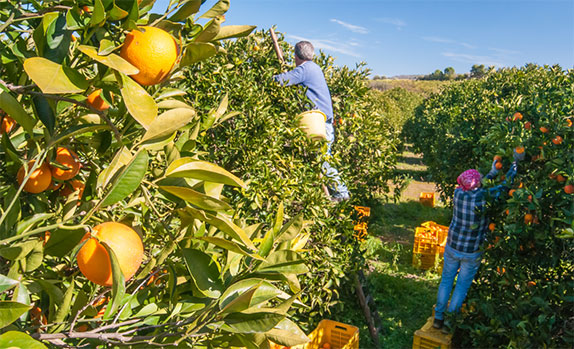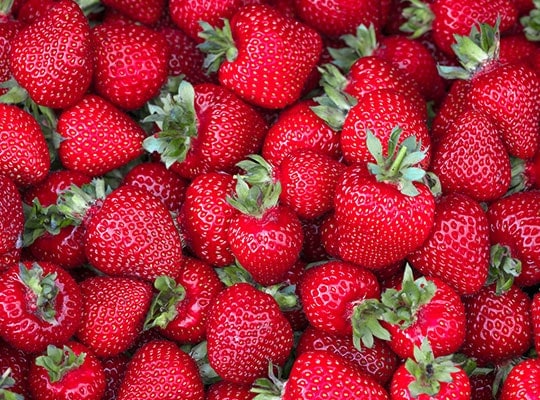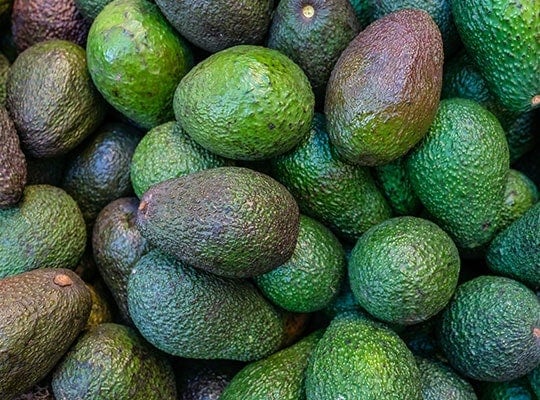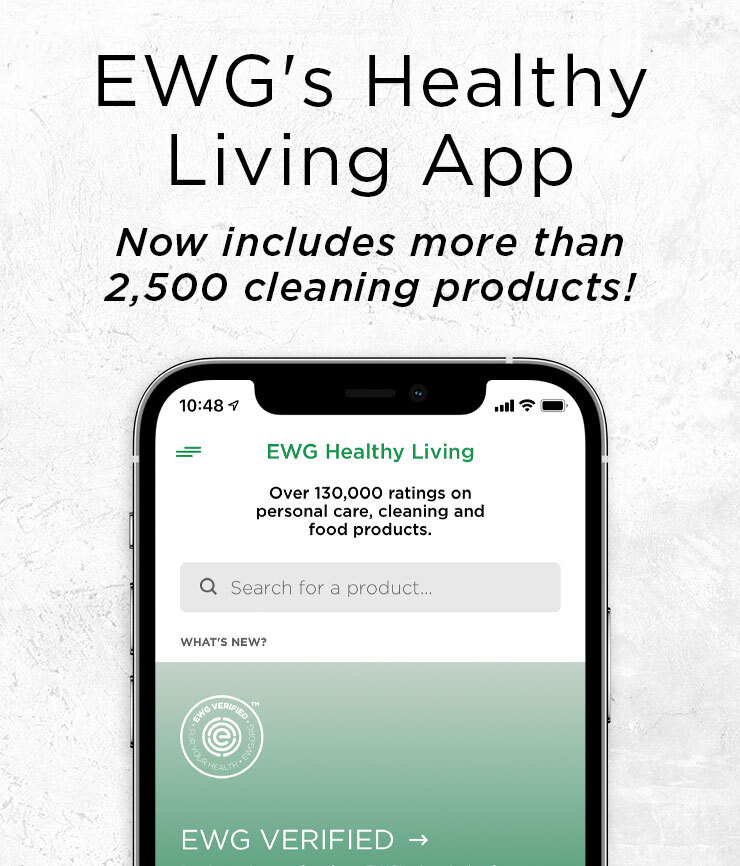EWG’s 2023 Shopper’s Guide to Pesticides in Produce™
By EWG Science Team
MARCH 15, 2023

Nearly 75 percent of non-organic fresh produce sold in the U.S. contains residues of potentially harmful pesticides, EWG’s 2023 Shopper’s Guide to Pesticides in Produce™ finds. In this year’s guide, blueberries and green beans join our Dirty Dozen™ list of the 12 fruits and vegetables sampled that have the highest traces of pesticides.
Any exposure to pesticides is a problem, given what we know about several ways they can harm humans. But the findings are particularly concerning for children, who are particularly vulnerable to many of the health harms associated with pesticide exposure.
The Shopper’s Guide represents EWG’s analysis of the latest fruit and vegetable testing data from the Department of Agriculture and Food and Drug Administration. The 2023 guide includes data from 46,569 samples of 46 fruits and vegetables. The USDA peels or scrubs and washes produce samples before testing, whereas the FDA only removes dirt before testing its samples. Even after these steps, the tests still find traces 251 different pesticides.
The guide includes our Dirty Dozen as well as our Clean Fifteen™, which shows which fruits and vegetables tested have very low or no traces of pesticides.
Some of the USDA’s tests show traces of pesticides long since banned by the Environmental Protection Agency. Much stricter federal regulation and oversight of these chemicals is needed.
Consumption of fruit and vegetables, organic or not, is critical to a healthy diet and good health. But for shoppers concerned about dietary pesticide exposure, EWG’s Shopper’s Guide, released every year since 2004, provides information about the fruits and vegetables with the highest and lowest pesticide residues, so consumers can make the best decisions for their families.
Pesticides – known to cause health problems
For this year’s guide, the overall picture remains problematic: Too many pesticides are still found in too high quantities on too much of the produce millions of Americans eat every day.
Many peer-reviewed scientific studies have shown disturbing links between pesticides and human health issues. These findings raise important questions about the safety of pesticide mixtures found on produce.
Research from Harvard University shows that consuming fruits and vegetables with high levels of pesticide residues may lessen the benefits of fruit and vegetable consumption, including protection against cardiovascular disease and mortality.
A recent EWG investigation published in the peer-reviewed journal Environmental Health found that the EPA has failed to adequately protect children from pesticides. For almost 90 percent of the most common pesticides, the agency has neglected to apply the Food Quality Protection Act–mandated children’s health safety factor to the allowable limits.
The threats pesticides pose to children’s health have been known since at least 1993 – 30 years ago – when the National Academies of Science published a landmark study warning of inadequate oversight. The American Academy of Pediatrics recommends parents concerned about their children’s exposure to pesticides consult EWG’s Shopper’s Guide.
Choosing organic fruits and vegetables can almost immediately reduce the amounts of residues in a person’s body, because the harmful chemicals used on non-organic, or conventional, produce are no longer a factor.
What’s new in the 2023 Shopper’s Guide
Blueberries and green beans are on the Dirty Dozen this year. Both crops still have troubling concentrations of pesticides that can harm the human nervous system, called organophosphate insecticides, though the levels have decreased over the past decade.
Several green bean samples had residues of acephate, a toxic pesticide, which the EPA banned more than 10 years ago from use on green beans grown for food.
Also this year, cantaloupe was removed from the Clean Fifteen, and carrots were added.

The 2023 DIRTY DOZEN
Of the 46 items included in our analysis, these 12 fruits and vegetables were most contaminated with pesticides:
- Strawberries
- Spinach
- Kale, collard and mustard greens
- Peaches
- Pears
- Nectarines
- Apples
- Grapes
- Bell and hot peppers
- Cherries
- Blueberries
- Green beans
Some highlights from the Dirty Dozen testing:
- More than 90 percent of samples of strawberries, apples, cherries, spinach, nectarines and grapes tested positive for residues of two or more pesticides.
- A total of 210 pesticides were found on Dirty Dozen items.
- Of those, over 50 different pesticides were detected on every type of crop on the list, except cherries.
- All of the produce on the Dirty Dozen had at least one sample with at least 13 different pesticides — and some had as many as as many as 23.
- Kale, collard and mustard greens, as well as hot peppers and bell peppers, had the most pesticides detected of any crop — 103 and 101 pesticides in total, respectively.
- The neurotoxic organophosphate insecticide acephate, prohibited from use on green beans in 2011, was detected on six percent of green bean samples.

THE 2023 CLEAN FIFTEEN
These 15 items had the lowest amounts of pesticide residues, according to EWG’s analysis of the most recent USDA data.1
- Avocados
- Sweet corn
- Pineapple
- Onions
- Papaya
- Sweet peas (frozen)
- Asparagus
- Honeydew melon
- Kiwi
- Cabbage
- Mushrooms
- Mangoes
- Sweet Potatoes
- Watermelon
- Carrots
Top takeaways for consumers:
- Almost 65 percent of Clean Fifteen fruit and vegetable samples had no detectable pesticide residues.
- Avocados and sweet corn were the cleanest produce – less than 2 percent of samples showed any detectable pesticides.
- Just over 10 percent of Clean Fifteen fruit and vegetable samples had residues of two or more pesticides.
- No sample from the first six Clean Fifteen items tested positive for more than three pesticides.
Where does Shopper’s Guide pesticide data come from?
The Shopper’s Guide combines data from USDA and FDA tests from 2021 and up to 10 years earlier, with the exception of pineapple data, which is from 2002.
The newest data released by the agencies included results of tests of more than 46,000 samples of produce, since it’s impossible to test every single piece of fruit and vegetable sold in the U.S. The USDA does not test every type of produce every year.
The USDA also does not test produce for all pesticides used in crop production. For example, glyphosate is the most heavily used pesticide in the U.S., and it can be found in high levels on several grains and beans, such as oats and chickpeas. But the USDA has not analyzed these crops for glyphosate.
EWG’s methodology involves six measures of pesticide contamination:
- Percent of samples tested with detectable pesticides.
- Percent of samples with two or more detectable pesticides.
- Average number of pesticides found on a single sample.
- Average amount of pesticides found, measured in parts per million.
- Maximum number of pesticides found on a single sample.
- Total number of pesticides found on the crop.
Why does EWG recommend reducing exposure to pesticides in your diet?
With the knowledge that pesticides are known to cause potential health problems, people can use the Shopper’s Guide to reduce their exposure to these chemicals when buying fruit and vegetables. One way to do this is by choosing organic produce.
Standards for growing organic produce ban the use of synthetic pesticides, which is a simple way to identify items likely to have no or minimal traces of those substances. Consumption of organically produced food reduces pesticide exposure and is linked to a variety of health benefits, according to multiple studies, especially findings from a large study in France .2,3
Clinical trials continue to show that people who switch from conventionally grown to organic foods see a rapid and dramatic reduction in their urinary pesticide concentrations, a marker of pesticide exposure.4 Other studies have linked higher consumption of organic foods to lower urinary pesticide levels, improved fertility and birth outcomes, reduced incidence of non-Hodgkin lymphoma, lower BMI and reduced risk of Type 2 diabetes. 2,3,5,6,7
Researchers from Harvard University used USDA test data and methods similar to EWG’s to classify produce as having high or low pesticides. 7 That study’s lists of high- and low-pesticide crops largely overlap with EWG’s Dirty Dozen and Clean Fifteen.
| Fertility studies' classification of pesticide residues | |
|---|---|
| High pesticide residue score | Apples, apple sauce, blueberries, grapes, green beans, leafy greens, pears, peaches, potatoes, plums, spinach, strawberries, raisins, sweet peppers, tomatoes, winter squash |
| Low to moderate pesticide residue score | Apple juice, avocados, bananas, beans, broccoli, cabbage, cantaloupe, carrots, cauliflower, celery, corn, eggplant, grapefruit, lentils, lettuce, onions, orange, orange juice, peas, prunes, summer squash, sweet potatoes, tofu, tomato sauce, zucchini |
The Harvard researchers also found that people who ate greater quantities of crops high in pesticides had higher levels of urinary pesticides and lower fertility.7,8 People who ate a pro-fertility diet, which included the low-pesticide crops, among other foods and nutrients, like whole grains and folic acid, were more likely to have a successful pregnancy.9
These studies don’t definitively show whether the positive effects associated with organic foods are directly and exclusively caused by lower pesticide exposures.
Are genetically modified crops affected by pesticides?
Genetically engineered crops, also known as genetically modified organisms or GMOs, are most commonly found in processed foods rather than in fresh produce.
Corn syrup and corn oil, produced from predominantly GMO starchy field corn, are commonly found in processed foods. But you may find genetically modified zucchini, yellow squash, sweet corn, papaya and apples in U.S. markets, though only papayas are predominantly GMO.
By law, some GMO food products in the U.S. must be labeled as such. But these labels may be difficult to interpret, with confusing terms like “bioengineered.” Consumers who want to avoid GMOs can choose organic zucchini, yellow squash, sweet corn, papaya, apples and potatoes. Processed goods that are certified organic or bear Non-GMO Project Verified labels can also be trusted to be GMO-free.
EWG provides several resources – including EWG’s Shopper’s Guide To Avoiding GMO Food, the Food Scores database and EWG’s Healthy Living app – to help consumers identify foods likely to contain genetically engineered ingredients.
U.S. pesticide regulations are inadequate
EWG is concerned about pesticides on produce because they are toxic by design, created expressly to kill living organisms – insects, plants and fungi considered “pests.” But many pesticides pose health dangers to people, too, including cancer, hormone disruption, and brain and nervous system toxicity. These hazards have been confirmed by independent scientists and physicians and U.S. and international government agencies.
Most pesticide residues found by USDA and FDA fall below government limits and are legal. But legal limits don’t always represent what’s safe for human consumption.
The conventional agriculture industry, and even the EPA, often claim pesticides are safe right up until the moment they are banned because of overwhelming evidence showing they are toxic to humans. Chlorpyrifos is a great example of this.
And many pesticides still legal for use in the U.S. have been banned in the EU because of the science showing threats to human health and wildlife. Four toxic neonicotinoids – imidacloprid, thiamethoxam, clothianidin and dinotefuran – remain legal for use here, even though the EPA has acknowledged their danger to insects like honeybees.
EWG is a strong advocate for strengthening our federal pesticide regulations. The EPA’s safety levels, called “tolerances,” help agency regulators determine whether farmers are applying pesticides properly. If tolerance levels were set to protect all children eating produce, as we believe they should be, more fruits and vegetables would fail.
We also urge the USDA and the FDA to more regularly test all commodities for pesticide residues and ensure they testing for all pesticides commonly used in agriculture. Federal agencies’ pesticide residue monitoring and dietary surveys do not adequately capture the variety of pesticide exposures Americans face.
Methodology
EWG’s Shopper’s Guide ranks pesticide contamination on 46 popular fruits and vegetables by analyzing 46,569 samples taken by the USDA and the FDA. Each year the USDA selects a subset of these fruits and vegetables to test, rather than testing all crops every year.
To create this guide, EWG uses data from the most recent one-to-two-year sampling period for each food. Since the USDA doesn’t test honeydew melon, EWG uses the FDA’s pesticide monitoring data for this crop.
| Food | Year | Source |
|---|---|---|
| Apples | 2015-2016 | USDA PDP |
| Asparagus | 2017-2019 | USDA PDP |
| Avocados | 2012 | USDA PDP |
| Bananas | 2019-2020 | USDA PDP | Bell and hot peppers | 2019-2021 | USDA PDP |
| Blueberries | 2020-2021 | USDA PDP |
| Broccoli | 2020-2021 | USDA PDP |
| Cabbage | 2017-2019 | USDA PDP |
| Cantaloupe | 2011-2012, 2019 | USDA PDP |
| Carrots | 2020-2021 | USDA PDP |
| Cauliflower | 2019-2021 | USDA PDP |
| Celery | 2014, 2021 | USDA PDP |
| Cherries | 2014-2016 | USDA PDP |
| Cherry tomatoes | 2012 | USDA PDP |
| Cucumbers | 2015-2017 | USDA PDP |
| Eggplant | 2020-2021 | USDA PDP |
| Grapefruit | 2015-2017 | USDA PDP |
| Grapes | 2016 | USDA PDP |
| Green beans | 2020-2021 | USDA PDP |
| Honeydew melon | 2008-2019 | FDA |
| Kale, collard and mustard greens | 2017-2020 | USDA PDP |
| Kiwis | 2018-2020 | FDA |
| Lettuce | 2015-2017 | USDA PDP |
| Mangoes | 2017-2018 | USDA PDP |
| Mushrooms | 2012-2013 | USDA PDP |
| Nectarines | 2014-2015 | USDA PDP |
| Onions | 2017 | USDA PDP |
| Oranges | 2016 | USDA PDP |
| Papaya | 2011-2012 | USDA PDP |
| Peaches | 2015, 2021 | USDA PDP |
| Pears | 2016, 2021 | USDA PDP |
| Pineapple | 2002 | USDA PDP |
| Plums | 2013, 2021 | USDA PDP |
| Potatoes | 2016 | USDA PDP |
| Raspberries | 2013 | USDA PDP |
| Snap peas | 2017-2018 | USDA PDP |
| Spinach | 2016 | USDA PDP |
| Strawberries | 2015-2016 | USDA PDP |
| Summer squash | 2020-2021 | USDA PDP |
| Sweet corn | 2014-2015 | USDA PDP |
| Sweet peas (frozen) | 2018-2019 | USDA PDP |
| Sweet potatoes | 2016-2018 | USDA PDP |
| Tangerines | 2019-2021 | USDA PDP |
| Tomatoes | 2015-2016 | USDA PDP |
| Watermelon | 2015, 2021 | USDA PDP |
| Winter squash | 2020-2021 | USDA PDP |
Before conducting tests, the USDA processes each piece of fruit or vegetable in the same way people tend to do at home. For example, those with inedible peels are peeled, and those with edible peels are rinsed under cold water and drained before they are tested. So the USDA test results are a good indication of consumers’ likely exposure.
Unprocessed produce tends to have higher concentrations of pesticides, as shown by California Department of Pesticide Regulation test results.
To compare foods, EWG considers six measures of pesticide contamination:
- Percent of samples tested with detectable pesticides
- Percent of samples with two or more detectable pesticides
- Average number of pesticides found on a single sample
- Average amount of pesticides found, in parts per million
- Maximum number of pesticides found on a single sample
- Total number of pesticides found on the crop.
Within each of these categories, we ranked the 46 fruits and vegetables and then normalized the ranks on a scale of 1 to 100, with 100 being the highest. For each food, we calculated a total score by summing the normalized rank from each metric. All categories are weighted equally, since they convey different but equally relevant information about pesticide levels on produce.
The USDA test program includes both domestically grown and imported produce, and sometimes ranks differ on the basis of origin. In these cases, we displayed domestic and imported items separately to help consumers select the option with the lowest pesticide levels.
The Shopper’s Guide to Pesticides in Produce full list shows how fruits and vegetables rank based on these total scores.
The Shopper’s Guide does not incorporate risk assessment into the calculations. All pesticides are weighted equally, and we do not factor in the levels deemed acceptable by the EPA. Research constantly provides new insights into the threats pesticides pose to human and environmental health. EWG designed this method to capture this uncertainty and enable consumers to reduce their overall pesticide load.
This article was adapted and updated from the 2021 Shopper’s Guide.
REFERENCES:
- USDA, Pesticide Data Program. Agricultural Marketing Service. Available at: www.ams.usda.gov/datasets/pdp.
- Vigar, V., et al., A Systematic Review of Organic Versus Conventional Food Consumption: Is There a Measurable Benefit on Human Health? Nutrients, 2020; 12(1), 7. DOI: https://doi.org/10.3390/nu12010007 . Available at: https://www.mdpi.com/2072-6643/12/1/7/htm .
- Kesse-Guyot et al. Key Findings of the French BioNutriNet Project on Organic Food-Based Diets: Description, Determinants, and Relationships to Health and the Environment. Adv Nutr. 2022 Feb 1;13(1):208-224. doi: 10.1093/advances/nmab105.
- Rempelos et al. Diet and food type affect urinary pesticide residue excretion profiles in healthy individuals: results of a randomized controlled dietary intervention trial. Am J Clin Nutr. 2022 Feb 9;115(2):364-377. doi: 10.1093/ajcn/nqab308.
- Kesse-Guyot et al. Prospective association between organicfood consumption and the risk of type 2 diabetes: findings from the NutriNet-Santé cohort study. International Journal of Behavioral Nutrition and Physical Activity, 2020; 17 DOI: 10.1186/s12966-020-01038-y. Available at: https://ijbnpa.biomedcentral.com/articles/10.1186/s12966-020-01038-y.
- Papadopoulou, E., et al., Diet as a Source of Exposure to Environmental Contaminants for Pregnant Women and Children from Six European Countries. Environmental Health Perspectives, 2019; 127(10). DOI: https://doi.org/10.1289/EHP5324 . Available at: https://ehp.niehs.nih.gov/doi/full/10.1289/EHP5324 .
- Chiu, Y.H., et al., Association Between Pesticide Residue Intake from Consumption of Fruits and Vegetables and Pregnancy Outcomes Among Women Undergoing Infertility Treatment With Assistance Reproductive Technology. JAMA Internal Medicine, 2018. DOI: 10.1001/amainternmed.2017.5038. Available at: http://jamanetwork.com/journals/jamainternalmedicine/article-abstract/2659557
- Chiu, Y.H., et al. Comparison of questionnaire-based estimation of pesticide residue intake from fruits and vegetables with urinary concentrations of pesticide biomarkers. Journal of Exposure Science and Environmental Epidemiology, 2018; 28, 31-39. DOI: https://doi.org/10.1038/jes.2017.22 . Available at: https://www.nature.com/articles/jes201722 .
- Gaskins A.J., et al. Dietary patterns and outcomes of assisted reproduction. American Journal of Obstetrics and Gynecology, 2019; 220:567.e1-18. Doi: 10.1016/j.ajog.2019.02.004.
- American Academy of Pediatrics, Organic Foods: Health and Environmental Advantages and Disadvantages. American Academy of Pediatrics Committee on Nutrition and Council on Environmental Health, 2012; e1406 -e1415. DOI: 10.1542/peds.2012-2579. Available at https://pediatrics.aappublications.org/content/130/5/e1406


 Skin Deep
Skin Deep
 Cancer Prevention Within Reach
Cancer Prevention Within Reach
 Shopper's Guide to Pesticides in Produce™
Shopper's Guide to Pesticides in Produce™
 Guide to Healthy Cleaning
Guide to Healthy Cleaning
 EWG's Tap Water Database
EWG's Tap Water Database
 Food Scores
Food Scores








